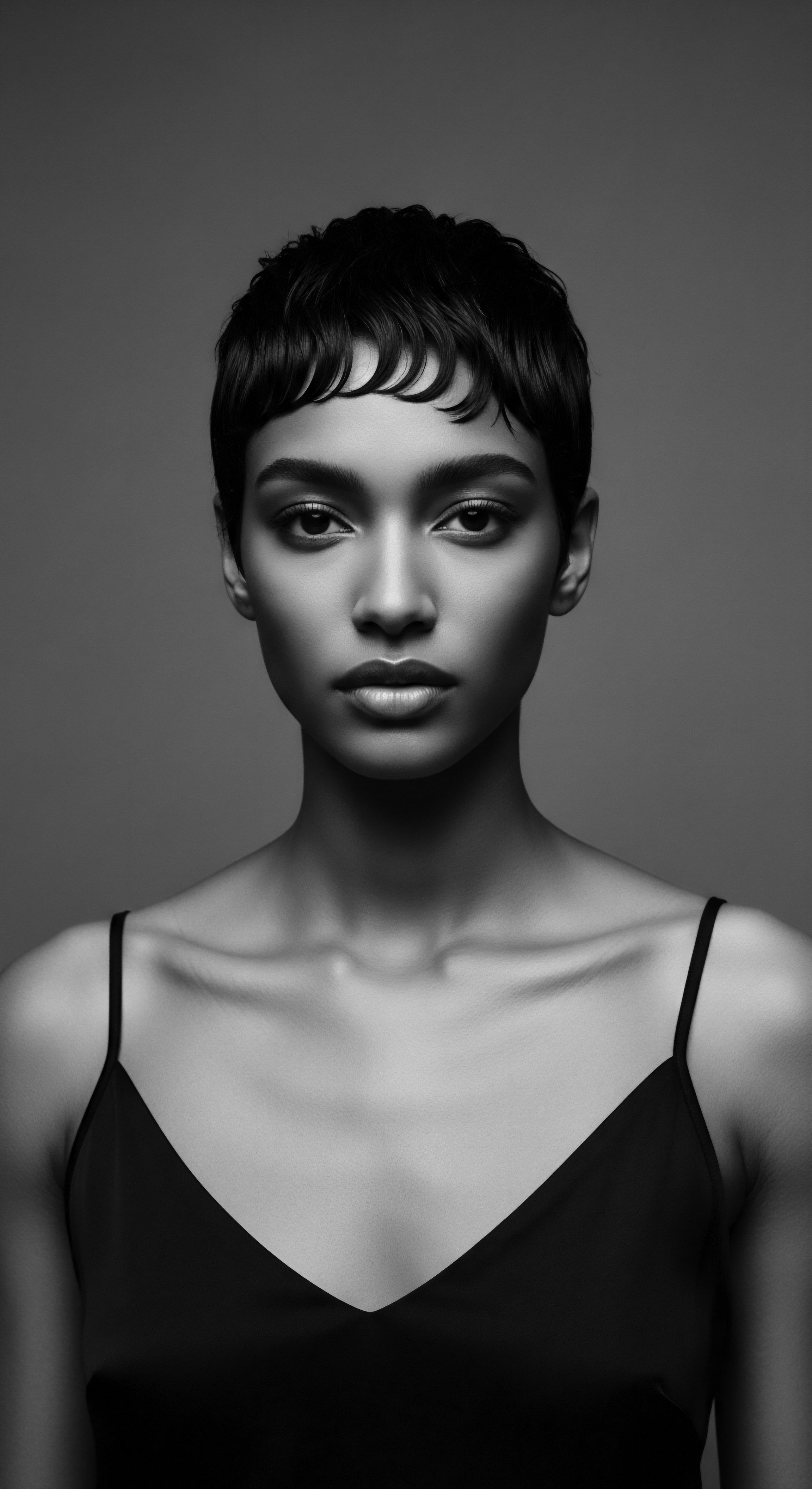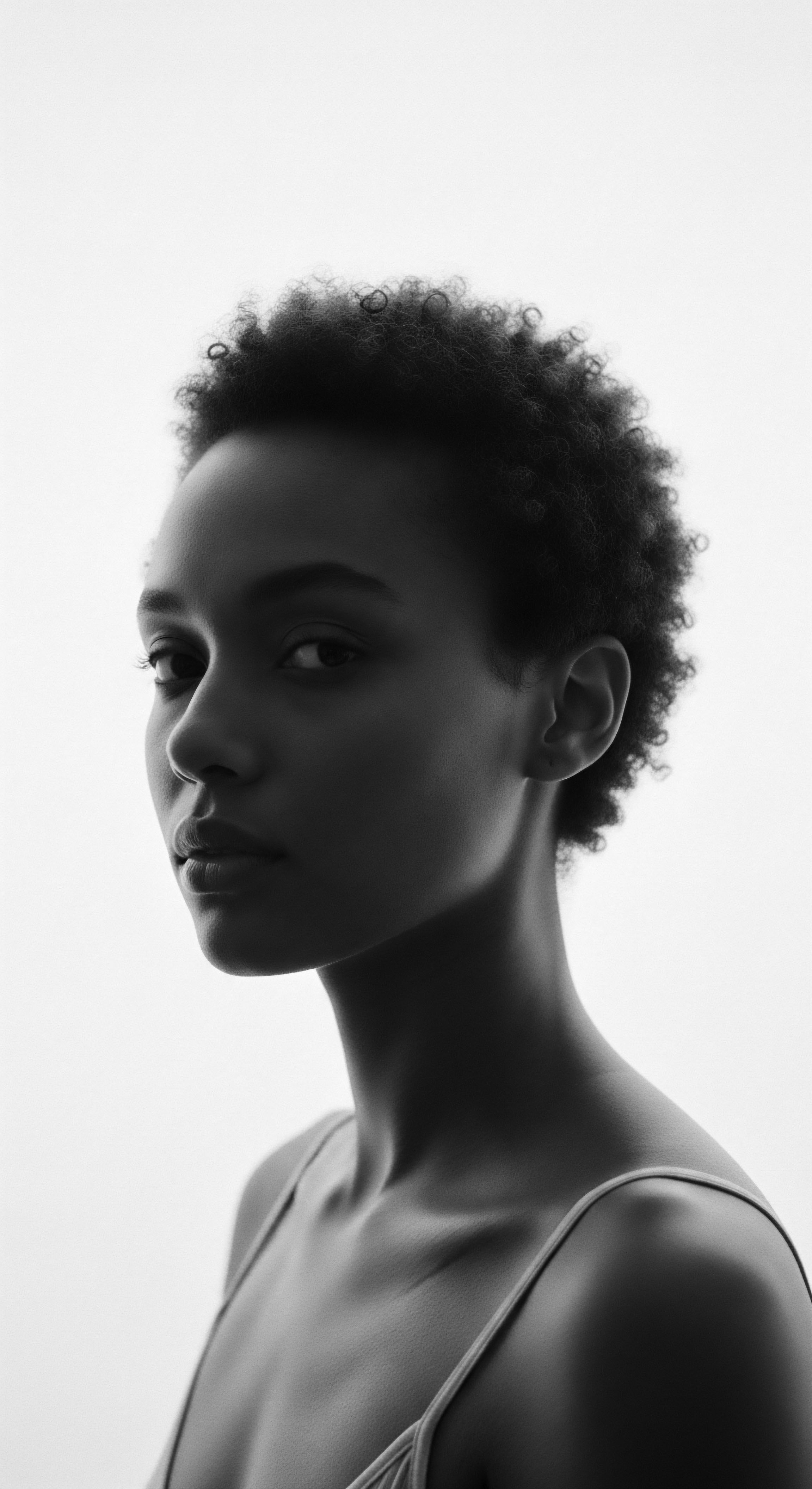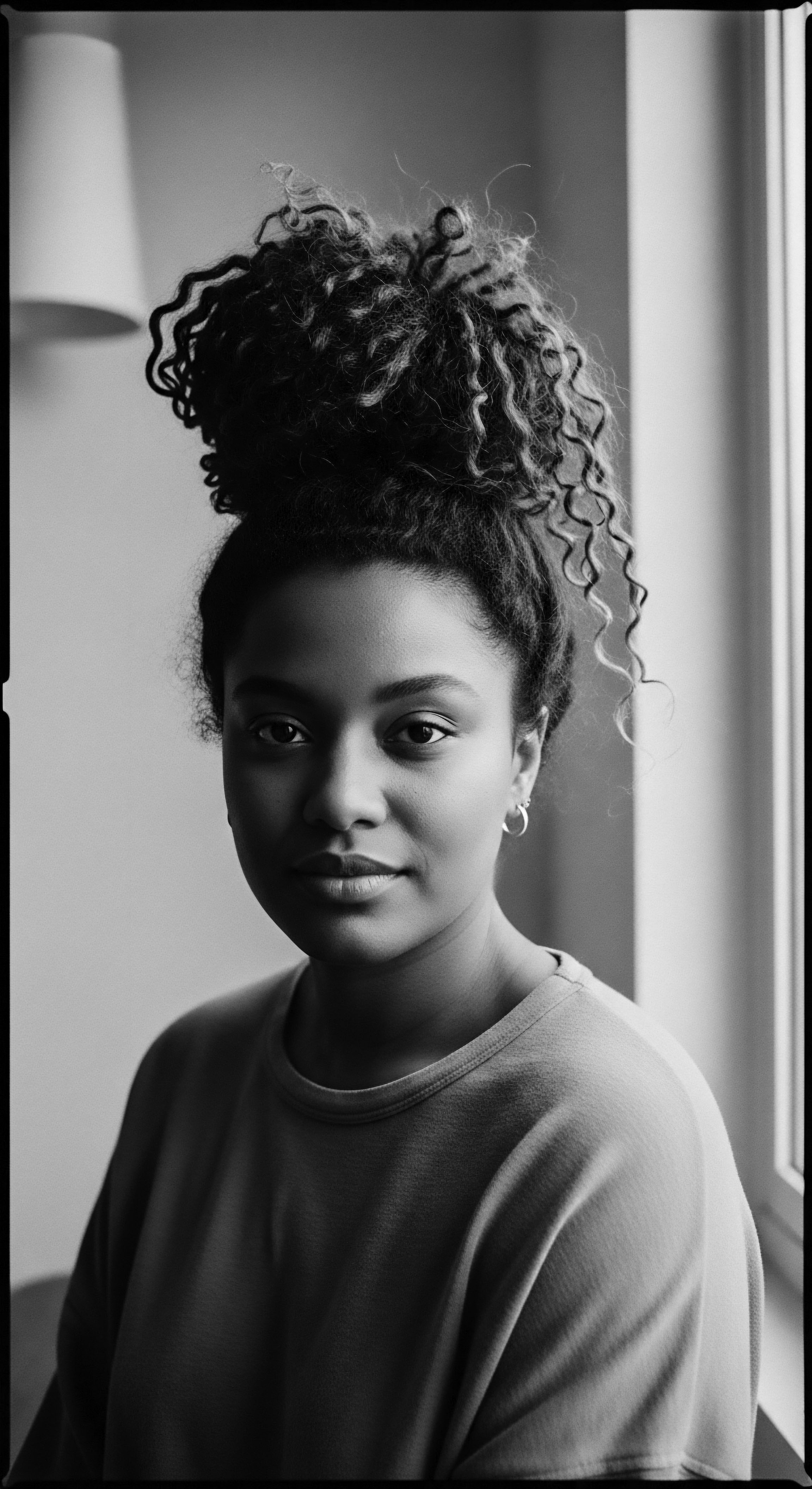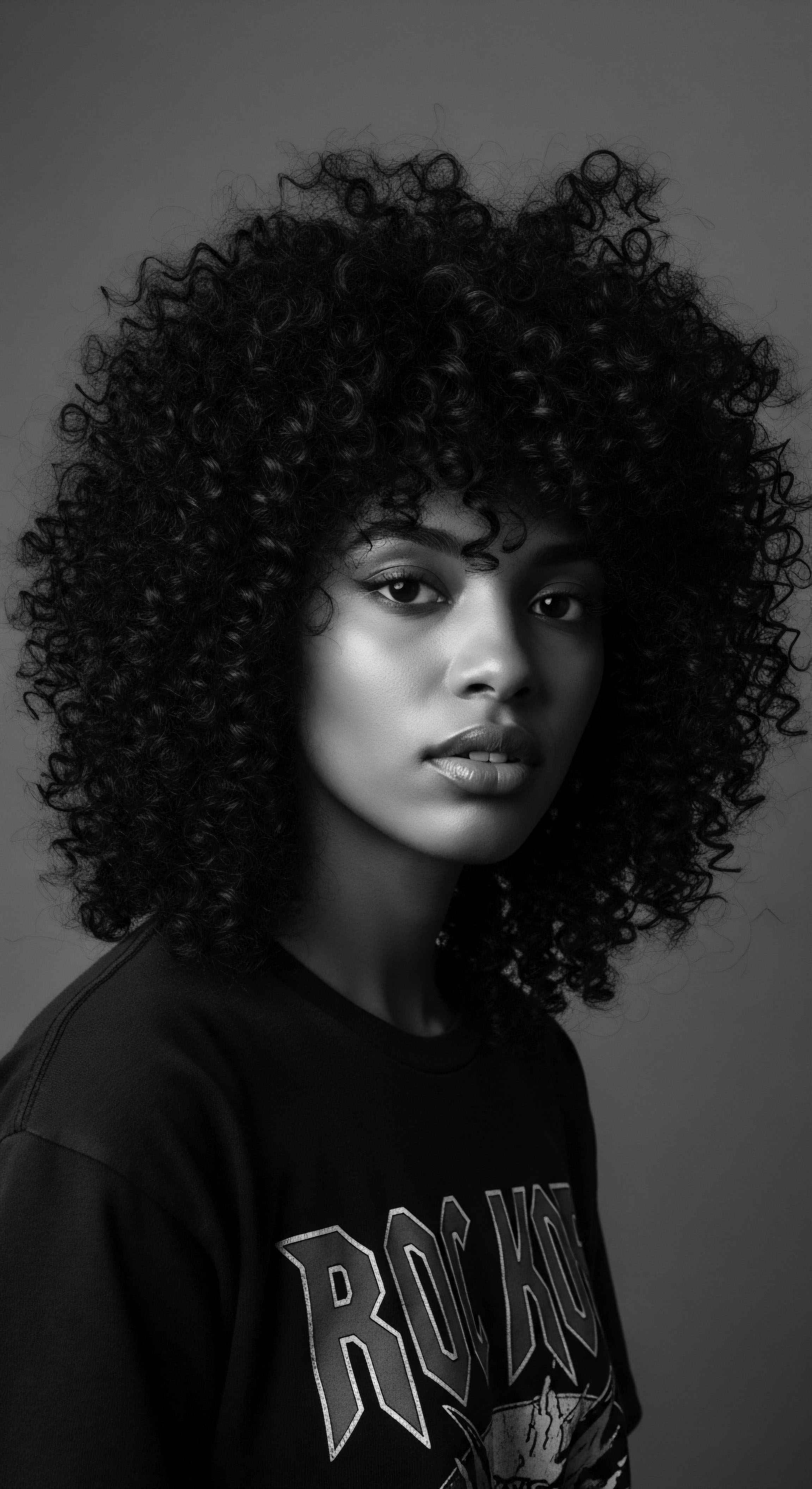
Fundamentals
The very ground beneath our feet holds a timeless narrative, a silent testament to cycles of creation and transformation. Within this profound geological story lies the essence of what we refer to as Ancient Clays, remarkable gifts from the earth that have cradled human hands and adorned human forms for millennia. These are not merely inert earth; they are dynamic mineral compositions, born from the patient alchemy of geological processes over vast, unimaginable stretches of time.
Each type, shaped by its unique origins, possesses a distinct chemical signature, a subtle blueprint of its inherent capacities. From the earliest communal gatherings, perceptive individuals recognized the extraordinary properties of these argillaceous deposits, intuitively understanding their potential to purify, to soothe, and to fortify the delicate structures of hair and skin.
In its most straightforward sense, the Meaning of Ancient Clays encompasses naturally occurring, mineral-rich earths—often derived from volcanic ash, weathered rock, or sediment—that were historically employed across diverse human cultures for their therapeutic and cosmetic attributes. Their utility for hair care, a practice intrinsically woven into the fabric of personal and collective identity, finds its earliest roots in a time when a deep, reverent connection to the natural world was the very rhythm of daily existence. This foundational understanding acknowledges the profound, reciprocal bond between human wellbeing and the earth’s abundant offerings. The designation “Ancient” speaks not only to their geological antiquity but, more importantly, to the deep well of ancestral knowledge passed down through countless generations, concerning their precise application and the discernible, often profound, benefits they offered to those who understood their power.

The Earth’s Tender Embrace ❉ Early Applications in Hair Heritage
Long before the advent of modern scientific instruments capable of isolating specific chemical compounds, our ancestors possessed an acute, embodied wisdom regarding the cleansing and conditioning power inherent in these mineral formations. Imagine, if you will, the vibrant early communities, their daily lives intimately attuned to the subtle cadences of the land. They observed how certain earth deposits, when gently mixed with water, transformed into a soft, pliable paste, a viscous balm capable of drawing impurities from the skin and, crucially, from the hair.
This deceptively simple observation ignited a quiet revolution in personal care, establishing the very groundwork for rituals that would persist, evolving yet enduring, through countless centuries. The primary Explanation of Ancient Clays’ initial widespread use lies in their remarkable absorbent and adsorbent qualities; they possessed the unique capacity to effectively lift dirt, excess oils, and environmental pollutants from the hair shaft and scalp without stripping away vital moisture, a particular and significant boon for the delicate, often intricately coiling structures characteristic of textured hair.
The Description of these early practices often paints a picture of communal gatherings by flowing rivers or natural springs, places where families and communities would engage in shared rituals of washing, conditioning, and adornment. These were seldom solitary acts; instead, they functioned as powerful communal affirmations of connection—a profound bond to one another, to their ancestral heritage, and to the very earth that sustained them. The application of these earths extended far beyond mere hygiene; it blossomed into a form of natural protection, serving as a gentle barrier against the harsh elements, and, perhaps most powerfully, transforming the hair into a living canvas for intricate adornment and cultural expression. This initial recognition of their purifying, soothing, and conditioning capacities forms the very bedrock of their enduring legacy within textured hair care traditions across the globe.
Ancient Clays, in their fundamental aspect, embody the earth’s primal offering for cleansing and nurturing hair, deeply rooted in ancestral care traditions and communal rituals.

Elemental Composition and Foundational Properties
To truly grasp the deeper Connotation of Ancient Clays, one must delve into their fundamental composition and the subtle dance of elements that define them. These remarkable materials are predominantly composed of hydrated aluminum phyllosilicates, often interwoven with various other essential minerals such as iron, magnesium, calcium, potassium, and silica. It is this unique, naturally occurring blend of elements that grants them their distinctive, multifaceted properties, setting them apart as agents of profound benefit. For instance, a significant number of these beneficial clays possess a net negative electrical charge when hydrated.
This intrinsic ionic property allows them to powerfully attract and bind to positively charged impurities, toxins, and excess sebum present on the hair and scalp. This phenomenon, known as cation exchange capacity, represents a core aspect of their purifying action, making them exceptionally effective yet gentle cleansers.
- Adsorption ❉ This refers to the capacity of the microscopic clay particles to attract and hold substances, like a gentle magnet, onto their vast surface area. This mechanism is crucial for drawing out environmental pollutants and product residues without penetrating the hair shaft.
- Absorption ❉ Distinct from adsorption, this property highlights the clay’s ability to soak up liquids, such as excess oils and sebum, from the scalp and hair strands. This helps to meticulously balance oil production, preventing greasiness without leading to excessive dryness, a delicate balance for textured hair.
- Mineral Content ❉ The inherent presence of various macro and trace minerals within the clay matrix is believed to offer profound nourishment and support a thriving, healthy follicular environment. These minerals contribute to the overall vitality and resilience of the hair and scalp.
The physical structure of these clays also plays an undeniable role in their efficacy. Many, when properly hydrated, form an incredibly fine, slippery paste, a luxurious emulsion that allows for effortless distribution through even the densest and most intricately coiling hair patterns. This smooth, unctuous texture significantly minimizes friction during application and rinsing, thereby aiding in gentle detangling and remarkably reducing breakage, a constant and critical consideration for individuals with delicate textured hair. The profound Interpretation of their efficacy, therefore, rests on a harmonious synergy between their precise chemical reactivity and their unique physical attributes, working in concert to support optimal scalp health and the enduring integrity of the hair fiber.

Intermediate
Moving beyond the foundational understanding, the deeper Significance of Ancient Clays truly begins to unfold when one considers their diverse forms and the remarkably specific ways various ancestral cultures integrated them into their hair care traditions. This is not a singular, monolithic concept, but rather a vibrant, living spectrum of practices, each meticulously shaped by local geology, prevailing climate conditions, and, crucially, the unique hair textures and cultural expressions of a given community. From the mineral-rich volcanic soils of the African continent to the ancient, fertile riverbeds of Asia and the Americas, distinct mineral earths emerged as favored agents for hair cleansing, conditioning, and even ceremonial adornment, each carrying its own profound lore, its specific practical applications, and its indelible mark on collective memory.

Regional Varieties and Their Distinctive Properties ❉ A Global Heritage
The earth, in its boundless generosity, offers a rich and varied palette of argillaceous materials, each possessing subtle yet meaningful variations in mineral composition that directly informed their traditional applications. Consider, for instance, the widely celebrated Rhassoul Clay, also known as Ghassoul, a remarkable smectite clay sourced exclusively from the ancient, majestic Atlas Mountains of Morocco. For untold centuries, this particular earth has served as a cornerstone of North African and Middle Eastern beauty rituals, revered for its profound benefits to both hair and skin.
Its remarkable capacity for both absorption and adsorption, coupled with a gentle drawing action, makes it an ideal agent for detoxifying the scalp and hair without stripping away essential natural oils. The meticulous Clarification of its properties reveals a notably high silica and magnesium content, which collectively contribute to its characteristic silken feel and its ability to leave hair feeling extraordinarily soft, supple, and remarkably manageable.
Another prominent example, revered across continents, is Bentonite Clay, a highly absorbent and expansive clay formed from the ancient decomposition of volcanic ash. It is found in various parts of the world, including significant deposits in the United States and France. This particular clay, exceptionally rich in montmorillonite, possesses a unique characteristic ❉ it swells considerably when hydrated, creating a potent net negative charge. This powerful ionic property allows it to excel at pulling positively charged impurities, heavy metals, and stubborn product buildup from the hair shaft and scalp.
Its traditional usage, particularly within various Indigenous American practices, often centered on its powerful drawing capabilities for both internal purification and external application, including profound hair and scalp treatments. The precise Elucidation of its mechanism reveals how it effectively creates a gentle, yet profoundly effective, detoxifying mask for textured strands, helping to redefine natural curl patterns and restore a vibrant vitality to the hair.
Then there is Kaolin Clay, a significantly softer, milder clay, often appearing in delicate white or pink hues, found globally across various geological formations. Unlike the more absorbent Rhassoul or Bentonite, Kaolin exhibits a lower absorption capacity, and is thus far less likely to strip moisture from the hair. This makes it particularly suitable for sensitive scalps or for hair types that require a supremely gentle touch, such as fine or easily dehydrated textured strands.
Its delicate nature made it a favored ingredient in traditional remedies for soothing irritation, calming inflamed skin, and providing a light, nourishing conditioning touch. The careful Delineation of its benefits highlights its crucial role in providing mild cleansing and a gentle mineral boost without any harshness, serving as a profound testament to ancestral understanding of nuanced, individualized care for diverse hair needs.
The varied geological origins of Ancient Clays gave rise to distinct mineral compositions, shaping their unique applications in traditional hair care across diverse global cultures.

Cultural Rituals and the Enduring Thread of Community
The application of Ancient Clays was, for most ancestral communities, rarely a solitary act; it was instead deeply embedded within rich cultural rituals that powerfully strengthened community bonds and meticulously passed down intergenerational wisdom. In countless African societies, for example, hair care transcended mere personal grooming to become a profoundly communal activity, a cherished time for storytelling, for sharing laughter and wisdom, and for nurturing connections. The careful preparation of clay mixtures, often meticulously infused with indigenous herbs, aromatic oils, and plant extracts, transformed into a sacred, almost meditative process. This precise Specification of practice goes far beyond simple cosmetic application; it speaks volumes about the holistic approach to wellbeing, where the physical act of hair care was inextricably linked to spiritual harmony and robust social health.
Consider the women of certain West African communities, where specific earth compounds were not only utilized for cleansing but also for the creation of elaborate, symbolic hair styling and adornment. These intricate practices were not simply about aesthetics; they served as powerful conveyors of status, age, marital state, spiritual beliefs, and tribal affiliation. The very act of applying these clays, often performed with rhythmic chants, ancestral songs, or the shared cadence of conversation, became a form of moving meditation, a tangible connection to the ancestors who had performed the exact same rituals for centuries. The meticulous Explication of these customs reveals how hair, and the very materials chosen to care for and adorn it, transformed into a powerful medium for non-verbal communication and profound cultural expression, particularly within communities where oral traditions served as the primary vessels for preserving knowledge and history.
| Clay Type (or Earth Mineral) Rhassoul (Ghassoul) |
| Geographic/Cultural Context North Africa (Morocco), Middle East |
| Primary Traditional Use for Hair/Scalp Deep cleansing, conditioning, scalp detoxification, hair softening, curl enhancement. |
| Associated Cultural Significance Central to Hammam rituals; a symbol of purity, beauty, and hospitality in traditional settings. |
| Clay Type (or Earth Mineral) Bentonite (Montmorillonite) |
| Geographic/Cultural Context Various, e.g. Indigenous Americas, France |
| Primary Traditional Use for Hair/Scalp Powerful drawing of impurities, clarifying scalp, absorbing excess oils, defining coils. |
| Associated Cultural Significance Integrated into Indigenous healing practices for drawing out toxins; connected to earth medicine and holistic wellness. |
| Clay Type (or Earth Mineral) Kaolin |
| Geographic/Cultural Context Global (e.g. China, France, UK) |
| Primary Traditional Use for Hair/Scalp Gentle cleansing, soothing irritated scalp, mild conditioning, light detangling. |
| Associated Cultural Significance Often used in more delicate cosmetic preparations; associated with gentleness, purity, and ceremonial body painting. |
| Clay Type (or Earth Mineral) Red Ochre/Clay Mixes |
| Geographic/Cultural Context Sub-Saharan Africa (e.g. Himba, Maasai) |
| Primary Traditional Use for Hair/Scalp Hair styling, adornment, sun protection, symbolic coloring. |
| Associated Cultural Significance Signifier of age, marital status, spiritual connection, and tribal identity; integral to rites of passage. |
| Clay Type (or Earth Mineral) These diverse earth materials, rooted in specific geological formations, represent a continuous, vibrant thread of ancestral wisdom in hair care, honoring the unique needs and profound cultural meanings of textured strands across human history. |
The meticulous preparation and thoughtful application of these clays often involved specific tools—gourds carved from hardened fruit, smoothed wooden spatulas, or carefully selected river stones—each carrying its own unique history and profound symbolic weight. The entire process itself transcended a mere chore, transforming into a deeply pedagogical moment, a sacred space where elders would patiently teach younger generations not only the precise practical steps but also the far deeper cultural Implication of the ingredients and the sacred nature of the ritual. This unbroken continuity of practice ensured that the invaluable knowledge of Ancient Clays, and their rightful, honored place in textured hair care, persisted with remarkable resilience through periods of immense societal change, colonial disruption, and the relentless pressures of assimilation. It stands as a testament to the enduring power of cultural memory.

Academic
The comprehensive Definition of Ancient Clays, when rigorously viewed through an academic lens, transcends simple mineralogical composition to encompass a profound and intricate interplay of geology, ethnobotany, cultural anthropology, and the nuanced science of hair biology. It represents not merely a historical curiosity or a quaint ancestral practice but a vibrant, living legacy, a powerful testament to humanity’s deep, often intuitive, understanding of the earth’s innate capacities for sustaining life, fostering wellbeing, and nurturing beauty. This rigorous academic inquiry seeks to meticulously unearth the intricate, often overlooked, connections between these elemental substances and the complex social, spiritual, and physiological dimensions of textured hair across the global diaspora. It demands a holistic approach, drawing insights from disparate fields to construct a truly comprehensive understanding.

Geochemical Underpinnings and Bio-Interaction ❉ A Scientific Delineation
From a rigorous scientific standpoint, Ancient Clays are typically classified as hydrous aluminum silicates, distinguished by their unique layered crystalline structures. Prominent examples include kaolinite, various forms of smectite (such as montmorillonite and bentonite), and illite. The remarkable efficacy of these materials in hair care stems directly from their distinctive physicochemical properties. For instance, the exceptionally high cation exchange capacity (CEC) characteristic of many smectite clays allows them to adsorb and absorb a significant quantity of substances from their environment.
This particular property is paramount in their historical and contemporary role as highly effective cleansing agents; the negatively charged clay particles function as microscopic magnets, powerfully attracting and binding to positively charged impurities, excess sebum, and stubborn product residues accumulated on the hair shaft and scalp. The profound Import of this precise mechanism is that it facilitates a deep, yet remarkably non-stripping, purification, meticulously preserving the delicate lipid barrier of the scalp and the natural, vital moisture of coiling hair strands, which are, by their very nature, particularly susceptible to dryness and mechanical damage.
Moreover, the intricate mineralogical profile inherent in these clays—rich in essential elements like silica, magnesium, calcium, iron, potassium, and trace minerals—strongly suggests a potential for direct dermal nutrient delivery. While the precise extent of transdermal absorption of these macro and trace minerals into the scalp remains a subject of ongoing dermatological and physiological research, centuries of consistent traditional use and extensive anecdotal evidence powerfully point to their profound soothing, fortifying, and revitalizing effects on the scalp environment. The precise particle size distribution and the unique swelling capacities characteristic of different clay types also significantly influence their tactile qualities, their ability to form stable, homogenous suspensions, and their ease of even application and subsequent rinsing from dense, intricately textured hair. This granular, micro-level scientific understanding provides a compelling Elucidation for the empirical observations meticulously gathered by our ancestors over countless generations, bridging ancient wisdom with modern analytical rigor.
Beyond their direct cleansing and conditioning roles, some clays exhibit specific properties that contribute to scalp health. For example, certain clays possess mild astringent qualities, which can help to regulate sebum production, a common concern for many with textured hair. Others, with their unique mineral profiles, may contribute to a balanced scalp microbiome, thereby supporting an environment conducive to healthy hair growth.
The Specification of these nuanced effects demonstrates that the selection of a particular clay in traditional practice was often highly deliberate, reflecting a deep, practical understanding of its precise benefits for specific hair and scalp conditions. This underscores the sophisticated empirical knowledge that underpinned ancestral hair care systems, a level of detail often overlooked in casual contemporary discourse.

Cultural Cartographies of Clay ❉ Ancestral Wisdom and Hair as Identity
The profound Substance of Ancient Clays within the expansive human story is most vividly and compellingly painted across the intricate cultural cartographies of indigenous and diasporic communities, particularly those with deep, unbroken connections to textured hair heritage. Anthropological studies, meticulously conducted over decades, consistently reveal the pervasive and profoundly significant role of earth-based materials in pre-colonial African societies, for example. These materials functioned not merely as utilitarian cleansing agents but as absolutely integral components of complex spiritual rites, powerful social markers, and nuanced aesthetic expressions.
Hair, in these rich and varied cultural contexts, was never simply hair; it was a potent, living signifier of identity, social status, spiritual connection, and lineage. It served as a vital form of non-verbal communication, conveying complex messages within and between communities.
Academic inquiry into Ancient Clays reveals their profound role as conduits of ancestral wisdom, meticulously connecting geological science with the rich, enduring cultural heritage of textured hair.
One compelling historical example of this profound cultural integration comes from the widespread, yet often overlooked in broader narratives, use of mineral earths and ochres across numerous sub-Saharan African ethnic groups for both hair and body adornment. Beyond simple hygiene, these practices profoundly imbued hair with layers of symbolic meaning. For instance, among various West African communities, specific earth pigments, often meticulously mixed with natural botanical oils or plant extracts, were thoughtfully applied to hair for ceremonial purposes. These applications signified critical rites of passage, communicated marital status, conveyed spiritual protection, or denoted tribal affiliation.
This application was far from merely superficial; it represented a deliberate, conscious act of cultural reinforcement, a tangible, living link to ancestral lineage and collective identity. The esteemed scholar Dr. Sylvia Ardyn Boone, in her seminal and widely referenced work, Radiance from the Waters ❉ Ideals of Feminine Beauty in Mende Art (1986), meticulously details how various earth-based applications, including those that almost certainly incorporated local clays or similar mineral compounds, contributed to a holistic and deeply integrated concept of beauty and spiritual well-being within the Mende society of Sierra Leone. This particular Delineation of practice powerfully highlights how the physical alteration and adornment of hair with natural, earth-derived materials became a profound, eloquent statement of belonging, cultural adherence, and spiritual resonance.
Moreover, the preparation and thoughtful application of these earth-based concoctions were, in many instances, deeply communal endeavors, transforming what might otherwise be a mundane chore into a shared, sacred ritual. This inherent communal aspect powerfully fostered the intergenerational transmission of invaluable knowledge, meticulously ensuring that the specific types of clays, their precise preparation methods, and their associated profound meanings were passed down with immense reverence and accuracy. The very act of applying these materials, often accompanied by ancestral storytelling, rhythmic chants, or the shared cadence of daily conversation, reinforced social cohesion and meticulously preserved a living, breathing archive of hair heritage.
This deep cultural Connotation elevates Ancient Clays far beyond mere ingredients; they become potent vessels of memory, embodying the remarkable resilience and the enduring spirit of communities that faced profound historical disruptions. They stand as a testament to the unwavering human need for connection—to the earth, to the past, and to each other.

The Unbound Helix ❉ Modern Validation and Future Pathways for Heritage
The contemporary scientific understanding of Ancient Clays, informed by rigorous modern methodologies and advanced analytical techniques, often serves to powerfully validate and significantly expand upon these ancestral insights. Advanced analytical chemistry now allows for the precise identification of the mineral components and their exact charge properties, meticulously confirming what traditional practitioners observed through centuries of empirical application and intuitive understanding. This robust scientific validation helps to gracefully bridge the perceived gap between ancient wisdom and contemporary practice, allowing for a profound, renewed appreciation of these remarkable natural resources. The precise Denotation of their effectiveness in current natural hair care formulations for textured hair often points to their exceptional ability to gently clarify without stripping, their capacity to provide essential minerals, and their remarkable power to enhance natural curl definition—qualities deeply valued and actively sought after in modern, holistic hair care routines.
The scholarly examination of Ancient Clays also invites a critical, much-needed re-examination of historical narratives surrounding hair care, particularly for Black and mixed-race individuals. For far too long, dominant, often Eurocentric, beauty standards frequently marginalized traditional practices, promoting products and methods that were, in many instances, actively detrimental to the inherent health and beauty of textured hair. By consciously re-centering Ancient Clays within the discourse, we powerfully acknowledge a heritage of sophisticated, earth-connected care that profoundly predates and often surpasses many modern chemical formulations in its gentle efficacy, its holistic benefits, and its intrinsic connection to wellbeing.
This critical, decolonizing perspective allows for a vital reclamation of ancestral practices, fostering a profound sense of pride, self-acceptance, and cultural affirmation within the textured hair community. The long-term Implication of this significant re-evaluation is the cultivation of a more inclusive, respectful, and ecologically conscious approach to hair care, one that honors the deep wisdom of the past while consciously looking toward a future of holistic wellbeing and cultural continuity.
- Ethnobotanical Research ❉ This involves meticulous deep dives into historical texts, invaluable oral traditions, and archaeological findings to comprehensively document specific earth materials, including various clays, that were traditionally used for hair care across different civilizations. The objective is to precisely understand their botanical associations, their precise cultural contexts, and their societal roles.
- Mineralogical and Spectroscopic Analysis ❉ This scientific approach entails the rigorous laboratory examination of clay samples using advanced techniques to determine their precise chemical composition, their unique crystalline structures, their particle size distribution, and their critical ion exchange capacities. The goal is to meticulously correlate these scientific properties with the empirically observed and traditionally understood benefits for hair and scalp.
- Socio-Cultural Impact Studies ❉ These investigations delve into how the consistent use of Ancient Clays profoundly shaped communal rituals, served as powerful identity markers, and influenced aesthetic ideals within various societies. A particular focus is placed on communities with rich, enduring textured hair traditions, exploring the intersection of material culture and social meaning.
- Sustainable Sourcing and Ethical Stewardship ❉ This area of academic inquiry examines the ethical and environmentally responsible methods for sourcing these invaluable natural materials in the contemporary era. It seeks to ensure their long-term availability for future generations while rigorously respecting their geographical origins, the communities traditionally associated with them, and the ecological balance of their source environments.
The rigorous academic pursuit surrounding Ancient Clays thus contributes significantly to the construction of a more complete, respectful, and nuanced narrative of hair care history. It provides a robust and intellectually compelling framework for understanding how seemingly simple earth materials held such profound Purport and transformative power in the lives of our ancestors, offering not just physical sustenance for hair but also deep spiritual grounding and vital cultural continuity. This scholarly exploration powerfully affirms the remarkable ingenuity of traditional practices and their enduring, often overlooked, relevance in a world increasingly seeking authentic, earth-connected, and historically informed solutions for holistic wellness and beauty.

Reflection on the Heritage of Ancient Clays
As we contemplate the remarkable journey of Ancient Clays, from the very bedrock of our planet to the tender, coiling strands of our hair, we find ourselves standing at a profound and contemplative crossroads. This exploration has been far more than a mere academic exercise; it has transformed into a deeply personal pilgrimage into the enduring heart of our collective textured hair heritage. The clays, these seemingly humble yet infinitely powerful gifts of the earth, are not simply inert mineral compounds; they are the silent, steadfast keepers of countless stories, the enduring echoes of ancestral hands, and the tangible reminders of a wisdom that profoundly predates written history. They represent an unbroken connection to the elemental source, a grounding force in a world that often pulls us away from our natural rhythms and the deep, inherent wisdom of the land.
The Soul of a Strand, for us, extends far beyond the physical hair itself; it encompasses the living spirit it carries—the rich lineage, the unwavering resilience, the unspoken narratives meticulously woven into every coil, every kink, every intricate pattern. Ancient Clays speak directly to this very soul, whispering truths across time. They serve as a powerful reminder that genuine care is not a modern invention but an ancient, sacred practice, meticulously refined through countless generations, born from an intimate, reciprocal relationship with the land and its bounties. When we consciously reach for a clay-based treatment today, we are not merely applying a product; we are, in a profound sense, participating in a timeless ritual, honoring the ingenuity and profound understanding of those who came before us, those who intuitively grasped the remarkable, often underestimated, power residing within the earth.
This enduring connection to elemental biology, nurtured through the tender thread of communal care and shared heritage, ultimately shapes the unbound helix of our evolving identity. The profound knowledge embedded within Ancient Clays empowers us to perceive our textured hair not as something to be constrained, manipulated, or altered to fit external molds, but as a sacred extension of self, deserving of profound reverence, gentle nourishment, and holistic attention. It graciously invites us to pause, to listen intently to the subtle whispers of the past, and to recognize that true, authentic beauty is often found in the most natural, most ancestral of ways. The rich legacy of these clays issues a compelling call to us ❉ to remember, to honor, and to diligently carry forward a tradition of self-care that is deeply rooted in history, beautifully authentic in its expression, and eternally connected to the life-giving embrace of the earth.

References
- Boone, S. A. (1986). Radiance from the Waters ❉ Ideals of Feminine Beauty in Mende Art. Yale University Press.
- Opoku, E. (2006). African Traditional Medicine. Nova Science Publishers.
- Robins, G. (1993). Women in Ancient Egypt. Harvard University Press.
- Waugh, B. L. (2019). The History of Black Hair ❉ A Cultural and Political Anatomy. The MIT Press.
- Carruthers, M. (2001). The Book of the Black Woman ❉ A History of African American Women’s Hair. Xlibris Corporation.
- Ahmad, R. (2018). Natural Hair Care ❉ A Complete Guide to Healthy Hair. CreateSpace Independent Publishing Platform.
- Rastogi, S. K. & Gupta, A. (2019). Clay Minerals ❉ Properties, Applications and Health Effects. Nova Science Publishers.
- Shepard, A. (2014). The Culture of Hair ❉ A History of Hair and the Human Experience. Self-published.
